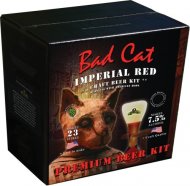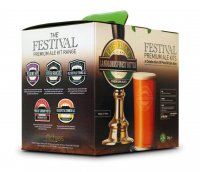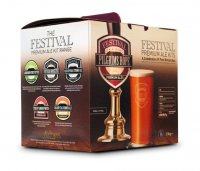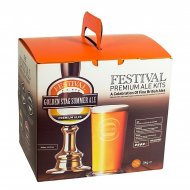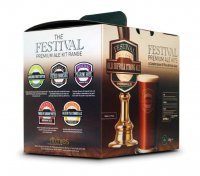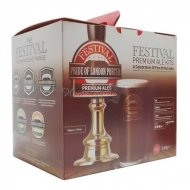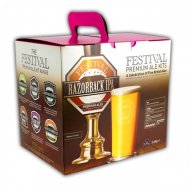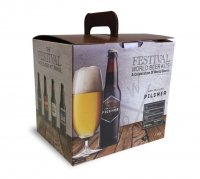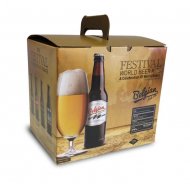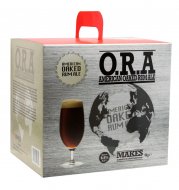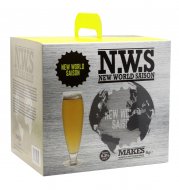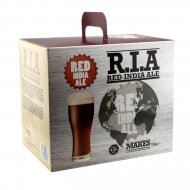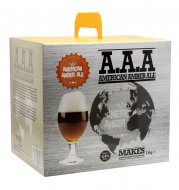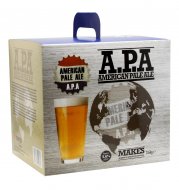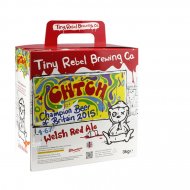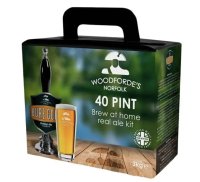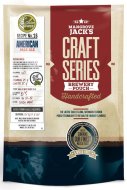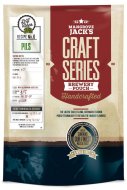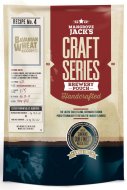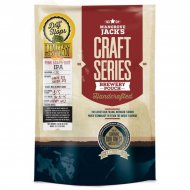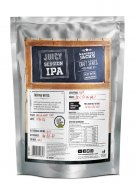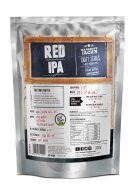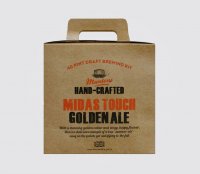Sign up to the Brew Mart newsletter for the latest news, offers & more
Please note that Brew Mart will be closed on Saturday, 5th July, AND Saturday, 12th July. Thank you.

Craft Beer Brewing Kits
The hallmark of a craft beer and craft brewery is innovation and attention to detail. Craft brewers value traditional methods and flavours and quality. Usually, these commercial breweries are independently owned and are smaller in size.
WHAT'S THE DIFFERENCE BETWEEN REGULAR BEER AND CRAFT BEER?
Generally speaking, craft beer is a beer that independent breweries make in small batches.
Regular beers tend to be aimed at more mainstream tastes, so they are brewed for familiarity by using essential, predictable ingredients and methods.
Craft beer is often explicitly brewed to appeal to more adventurous tastes, but some beers do have accessible flavours.
Real lovers of craft beer merely satisfy their tastes and are thrilled to get the chance to try new beers and introduce friends to them. Visit a local beer festival, and you'll hear nothing but laughter and lively chat discussing beers.
Some would say that mass production differentiates craft beers from regular ones. That doesn't hold true. Beer that's made with quality ingredients and brewed to perfection can be made in 10-litre batches or 10,000-litre batches as long as the process is modified to take the scale into account.
The main value of craft beer is that craft beer drinkers are more than willing to pay a little more for a beer with more taste, flavour, variety, and alcohol. The magical flavours which these beers offer are finely tuned and tweaked, then aged to give a delicious taste and quality you won't find in mass-produced beers.
WHAT IS CONSIDERED CRAFT BEER?
Craft beer is mainly made with traditional ingredients such as malted barley; however, non-traditional ingredients are often added to give that distinctiveness.
If Brew Mart were to define craft beer, we'd say it's a beer that's made with an independent mind, designed to appeal to more experienced palates and with a complex flavour. No particular flavour or ingredients would make a beer "craft", though.
It's not a judgement on the drinker. There's no right or wrong. It's only taste.
Brew Mart has an impressive range of craft home brew beer kits for you to choose from which includes beer from these manufacturers which includes all the different types of craft beer such as bitters , porters, pilsners and more.
- Festival
- Mangrove Jacks
- Tiny Rebel IPA
- Woodfordes
- Youngs
The Craft Brewery Experience:
Discovering the Perfect Brew for Every Palate
Are you a beer enthusiast? Do you enjoy the rich and diverse flavours that craft beer has to offer? If so, get ready to embark on a compelling journey through the world of craft brewery. From hoppy IPAs to smooth and velvety stouts, there is a perfect brew for every palate waiting to be discovered.
Join us as we delve into the art of brewing, exploring the intricate process of creating these flavour masterpieces. We'll uncover the secrets behind the perfect balance of malt, hops, and yeast and how they come together to create unique and unforgettable tasting experiences.
Whether you're a seasoned beer connoisseur or just starting to appreciate the world of craft beer, this guide will take you on a sensory adventure, helping you find your new favourite brew and enhancing your appreciation for the craftsmanship behind each pint. So, grab a glass, sit back, and embark on a journey to discover the perfect beer for your palate. Cheers!
The History and Evolution of Craft Brewery
Craft brewery has a rich history that dates back thousands of years. It all started with ancient civilisations such as the Sumerians and Egyptians brewing beer long before it became a commercial enterprise. These early brewers used simple ingredients like barley, water, and yeast to create their concoctions, and their brewing methods were often passed down through generations.
Fast forward to the Middle Ages, and we see the rise of monastic brewing.
Monks in European monasteries played a crucial role in refining the brewing process, perfecting recipes, and experimenting with different ingredients. They were known for their attention to detail and dedication to quality, laying the foundation for the craft brewery we know today.
However, it wasn't until the late 20th century that craft beer truly began to thrive. In the United States, the craft brewery revolution gained traction in the 1970s and 1980s, with pioneers like Fritz Maytag of Anchor Brewing and Ken Grossman of Sierra Nevada leading the charge. These brewers focused on creating unique and flavourful beers that challenged the status quo.
Today, craft brewery has become a global phenomenon, with breweries popping up in every corner of the world. The craft brewery movement has created diverse styles, flavours, and brewing techniques, offering beer lovers endless options to explore and enjoy.
Different Types of Handcrafted Beer and Their Characteristics
Craft beer comes in a wide variety of styles, each with its unique characteristics and flavour profiles. Understanding the different types can help you navigate the beer landscape and find the perfect brew for your palate.
- **Pale Ales**: Pale ales are known for their vibrant hop flavours and aromas. They have a balanced malt backbone ranging from light and refreshing to bold and assertive. Some popular styles include American Pale Ale (APA), English Pale Ale, and Belgian Pale Ale.
2. **India Pale Ales (IPAs)**: IPAs are characterised by their intense hop bitterness and aroma. They originated in England but gained popularity in the United States. IPAs can be further categorised into sub-styles like American IPA, English IPA, and Double IPA, each with its hop profile and level of bitterness.
3. **Stouts and Porters**: Stouts and porters are dark, rich, and full-bodied beers. Stouts are typically made with roasted barley, giving them a distinct coffee or chocolate-like flavour. On the other hand, porters have a more balanced malt profile and can be slightly sweeter. Some popular styles include American Stout, Irish Dry Stout, and Baltic Porter.
4. **Wheat Beers**: Wheat beers are light and refreshing, often with a cloudy appearance. They are made with a significant proportion of wheat malt, which gives them a smooth and creamy mouthfeel. Popular styles include German Hefeweizen, Belgian Witbier, and American Wheat Beer.
5. **Sours**: Sours are a unique category of beers known for their tart and acidic flavours. They are typically brewed using wild yeast or bacteria, giving them distinctive characteristics. Sours can range from mildly tart to mouth-puckeringly sour and can be flavoured with fruits or other ingredients.
Popular Craft Beer Styles and Their Flavour Profiles
Craft beer offers various styles, each with its unique flavour profile. Let's look at some of the most popular beer styles and what makes them stand out.
- **IPA**: IPAs are renowned for their bold hoppy flavours and aromas. They often have a citrusy, piney, or floral character, with a strong bitterness that can linger on the palate. The malt profile in IPAs is usually balanced, allowing the hops to take centre stage.
2. **Stout**: Stouts are dark, rich, and full-bodied beers with flavours of roasted malt, chocolate, and coffee. They can range from sweet to dry, with some variants incorporating additional ingredients like oats or lactose for added complexity.
3. **Pale Ale**: Pale ales are characterised by balanced malt and hop profiles. They often have a moderate bitterness and can exhibit citrus, pine, or tropical fruit flavours.
4. **Sour**: Sours are known for their tart and acidic flavours, achieved through wild yeast or bacteria. They can range from mildly tart to intensely sour, with flavours reminiscent of fruits like cherries or raspberries.
5. **Wheat Beer**: Wheat beers are light and refreshing, with flavours of bread, banana, and clove. They often have a slightly hazy appearance and a smooth mouthfeel.
These are just a few examples of the various craft beer styles available. Each type offers a unique taste experience, allowing beer lovers to explore and discover new flavours with every sip.
Exploring Local Craft Breweries and Their Offerings
One of the best ways to experience the world of craft beer is by visiting local breweries. Craft breweries are known for their passion and dedication to brewing, and many offer taprooms where you can sample their creations straight from the source.
When visiting a craft brewery, you'll often find a wide selection of beers on tap, ranging from their flagship brews to seasonal and limited-edition releases. This allows you to try different styles and flavours and perhaps even find a new favourite beer.
In addition to the beer, many breweries offer tours where you can learn about their brewing process and get a behind-the-scenes look at their facilities. These tours can be a fascinating experience as you gain insight into the craftsmanship and attention to detail that goes into creating each batch of beer.
We are blessed with many craft breweries in Sheffield and the surrounding areas. Some of which provide tours, open days or brewing courses. Supporting local breweries is not only a great way to enjoy delicious craft beer, but it also helps contribute to the growth and sustainability of the beer industry. So next time you want to try something new, consider visiting a local craft brewery and see what they offer.
How to Taste and Appreciate Craft Beer
Tasting craft beer is a skill in itself. To appreciate each brew's full complexity and nuances, it's important to engage all of your senses. Here are some steps to help you taste and enjoy craft beer like a pro:
- **Appearance**: Begin by observing the beer's appearance. Note its colour, clarity, and the size and persistence of its head. The head can give clues about the beer's style and potential flavour profile.
2. **Aroma**: Take a moment to inhale the beer's aroma. Gently swirl the beer around the glass to release its aromatics, then sniff deeply. Pay attention to the different scents you detect, such as hops, malt, fruits, or spices. The aroma can provide valuable insight into the beer's flavour.
3. **Taste**: Take a small sip of the beer and let it coat your palate. Pay attention to the initial flavours that hit your tongue and any lingering tastes. Note the beer's sweetness, bitterness, acidity, and any other flavours that come through. Consider how the flavours evolve as you continue to sip.
4. **Mouthfeel**: Evaluate the beer's mouthfeel, which refers to its texture and body. Is it light and crisp, or heavy and full-bodied? Is there a pleasant carbonation level? The mouthfeel can greatly impact your overall experience of the beer.
5. **Finish**: Pay attention to the beer's finish. Does it leave a lingering aftertaste? Is it dry or sweet? The finish can provide additional insights into the beer's complexity and balance.
By following these steps and savouring each sip, you'll fully appreciate craft beer's craftsmanship and flavours. And remember, tasting beer is a subjective experience, so don't be afraid to trust your taste buds and preferences.
Pairing Craft Beer with Food for the Ultimate Gastronomic Experience
Craft beer and food pairing is a match made in heaven. Just as different wines complement specific dishes, certain craft beers can enhance the flavours of your favourite foods. Whether you're enjoying a casual meal or hosting a dinner party, here are some tips for pairing craft beer with food:
- **Consider the Intensity**: Start by considering the intensity of the beer and the food. Lighter beers, such as wheat beers or lagers, work well with delicate flavours, while stronger and more complex beers, like stouts or IPAs, can stand up to bolder dishes.
2. **Match Intensity**: Aim to match the intensity of the dish and the beer. For example, a hoppy IPA can pair well with spicy foods, as the bitterness can help offset the heat. Similarly, a rich and malty beer like a stout can complement dishes with roasted or caramelised flavours.
3. **Contrast Flavours**: Look for contrasting flavours that complement each other. For instance, a citrusy beer can provide a refreshing contrast to fatty or fried foods, while a malty beer can balance the saltiness of certain cheeses.
4. **Experiment**: Don't be afraid to experiment and try different combinations. Craft beer offers such a wide range of flavours that endless pairing possibilities exist. The key is to have fun and discover what works best for your palate.
By exploring different beer and food pairings, you can elevate your dining experience and discover new and exciting flavour combinations. So next time you plan a meal, consider reaching for a craft beer that perfectly complements your dish.
Craft Beer Festivals and Events to Attend.
Craft beer festivals and events are a great way to immerse yourself in the world of craft beer and discover new breweries and flavours. These gatherings bring together beer enthusiasts, brewers, and industry professionals, creating a vibrant and celebratory atmosphere. Here are some craft beer festivals and events you won't want to miss:
- **Great American Beer Festival**: Held annually, the Great American Beer Festival in Denver is one of the larger and more prestigious beer festivals in Colorado and the United States. It features over 4,000 beers from more than 800 breweries, educational seminars, and tasting events.
2. **Oktoberfest**: Originating in Munich, Germany, Oktoberfest has become a worldwide celebration of beer. It typically runs for 16 to 18 days, attracting millions of visitors who enjoy traditional German beers, food, and music.
3. **Belgian Beer Weekend**: Held in Brussels, Belgium, the Belgian Beer Weekend showcases the rich brewing heritage of Belgium. It features over 350 Belgian beers, including Trappist ales, lambics, and other unique styles.
4. **Craft Beer Week**: Many cities worldwide host craft beer weeks, featuring various events such as tap takeovers, beer tastings, and brewery tours. These events provide an opportunity to discover local breweries and sample their offerings.
4a. **Sheffield Beer Week**: Sheffield Beer Week is a week-long festival celebrating the region's brewing landscape – old and new! It's also about highlighting the wonderful craft of beer making, taking and sharing inspiration from across the globe. Sheffield's bars, pubs and restaurants join forces with local breweries and breweries worldwide to host events centred around beer. Sheffield Beer Week happens across the city in multiple venues in the second week of March; Imagine a week where there will be unique beer events to enjoy every day! Pubs hosting beer festivals, bars having tap takeovers, breweries holding open days, and restaurants offering menus with tailored beer pairings.
Attending beer festivals and events like these lets you sample various beers, meet fellow beer enthusiasts, and learn from industry experts. It's an excellent way to expand your knowledge and passion for craft beer.
Brew Your Own Craft Beer: A Beginner's Guide
If you're truly passionate about craft beer, you may want to brew your own craft beer at home. Home brewing allows you to create unique beers, experiment with different ingredients, and better understand the brewing process. Here's a beginner's guide to help you get started:
- **Gather Your Equipment**: To begin brewing, craft beer at home you'll need basic equipment, including a fermenter, airlock, siphon, and thermometer. You can find home brewing starter kits that include these essentials.
2. **Choose a Recipe**: Select a recipe that aligns with your taste preferences and brewing experience. Start with a simple recipe, such as a pale ale or wheat beer, before progressing to more complex styles.
3. **Sanitise Everything**: Sanitation is crucial in home brewing to prevent contamination. Ensure thoroughly clean and sanitise all your equipment before and after each use.
4. **Brewing Process**: Follow the instructions provided in your recipe to brew your beer. Brewing typically involves boiling the ingredients, adding hops and other flavourings, and fermenting the mixture using yeast.
5. **Fermentation**: After brewing, transfer the mixture to a fermenter and let it ferment for the specified period. Fermentation is when the yeast converts sugars into alcohol and carbon dioxide.
6. **Bottling**: Once fermentation is complete, it's time to bottle your beer. Add some brewing sugar to carbonate the beer, then transfer it to individual bottles or kegs.
7. **Patience**: Patience is key in home brewing. Allow your beer to carbonate and age for the recommended time before opening and enjoying.
Home brewing is a very rewarding hobby that allows you to unleash your creativity and enjoy your creations with friends and family. With practice and experimentation, you can develop your signature brews that reflect your unique taste preferences.
Not sure where to start check out these articles?










